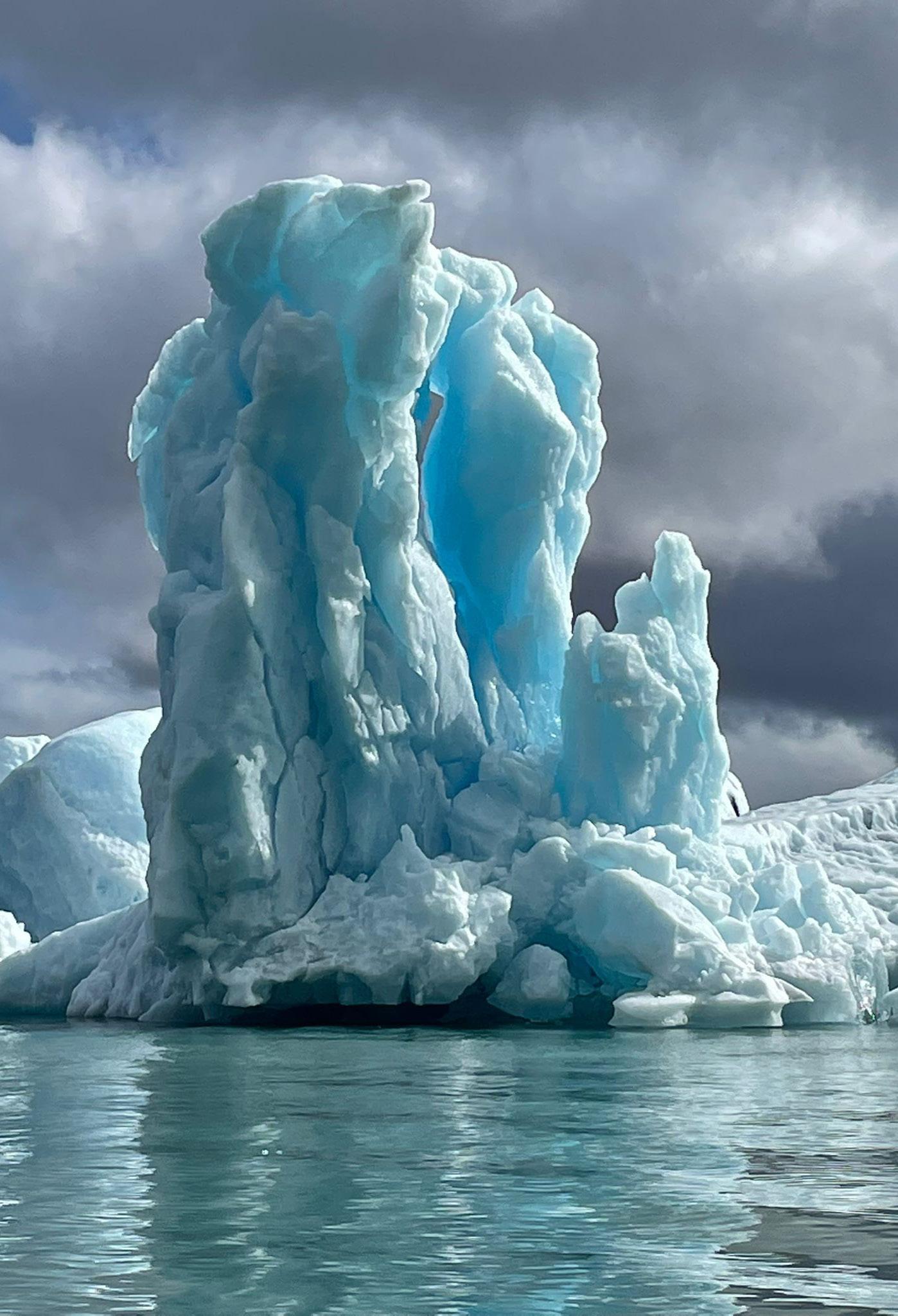

THe OCTOBER - DECEMBER 2022 HALF TERm 2
BAROMETER
CONTENTS:
History Symposium ReviewDan R and Max S, Year 12
Experiencing a Japanese Autumn - Mikey W, Year 7
A Comprehensive Review of the Mid-Term ElectionsFelipe E, Year 8
Museum of Danish Resistance - Woody F, Year 12
How Learning a New Language Does More Than You Think - Jonathan P, Year 10
Why Data Compression Matters - Daniel W, Year 9
Researching Local Buildings: A Starting Point - Kaveh K, Year 11
Arjun’s Science Update: The Immortal Jellyfish and The Mysterious Banana AncestorsArjun D, Year 12 Microplastics - Tyler B, Year 12
The Story of the Tu-104, Stepan K, Year 13
Comanche Sailing - Frederik B, Year 8
The Barbarians (Baa-Baas) vs All Blacks - Andrew H, Year 12
England vs Pakistan T20Sebastian H-H, Year 9
F1 News and Debate ClubStepan K, Year 13
Should Michael Masi Have Been Sacked? - Panos K, Year 9 An Interview With Miss
Vanags - Felipe E, Year 8
The Woman King Movie - Sam M, Year 9
Fall 2022 Anime Season - Zain S, Year 10
Safi Coffee - Felipe E and Frederik B, Year 8
Best Games in 2022 - Ian S, Year 10
Timely Comics - Jake P, Year 9
This is Horizon: Forbidden West - Hassan Y-N, Year 7
Cover Photograph: Stepan K, Year 13
Write for the Barometer
Contributing
to the Barometer is a great way to earn gold notes, improve your writing, and it looks great on your CV To submit articles or cover photos, join the Barometer club at Friday lunchtimes (B11) Or, you can email Mr s Bradley at nicola.bradley @wetherbysenior.co.uk Read the latest issue at https://issuu.com/wetherbysenior
Dan R, Year 12 writes...
Here Ye, Here Ye! Gather around come one, come all!
Last half term on Thursday 13 October, I, and all other A Level History and Politics sixth formers, had the pleasure of attending a history symposium with Queen’s College’s A Level History cohort in our Drama Studio.
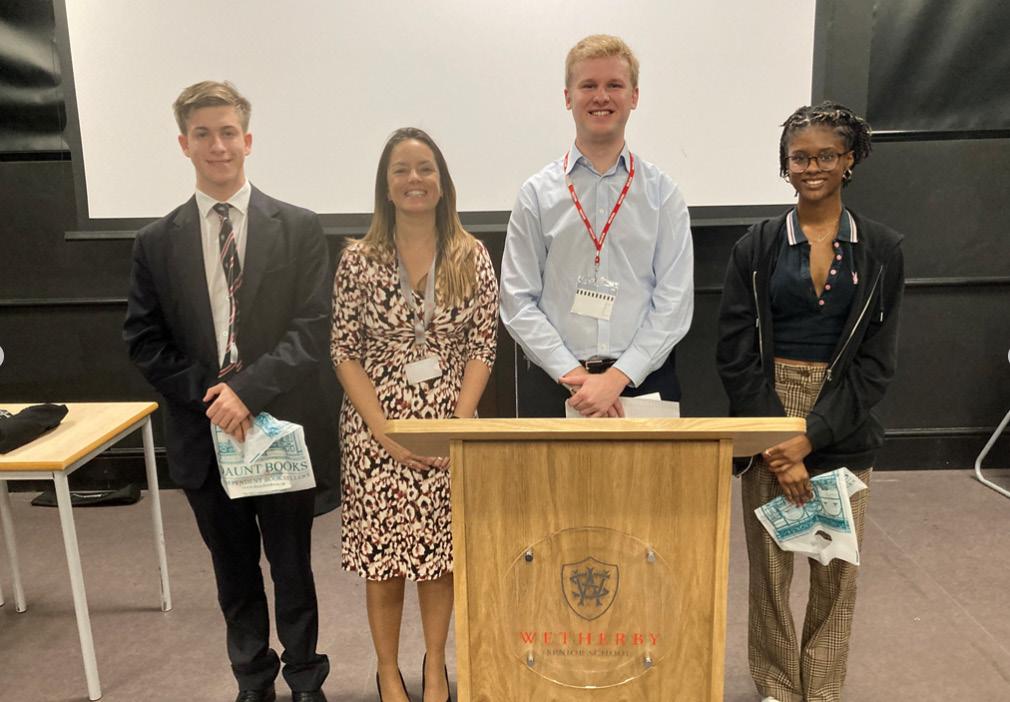
The overall theme of the discussion was London, from the start as Londinium to now, leading to engaging presentations discussing the evolution of epidemic treatment methods in the city (especially important now!) from Andrew in Year 13, and the migration of Eastern Europeans to the capital since 1900 from Tamerlan (also highly relevant!), alongside a multitude of other topics from Wetherby Senior and Queen’s College sixth formers alike.
Did you know London was only half a square mile large when it was formed? The best speeches were presented with an award as pictured here but, honestly,
HISTORY SYMPOSIUM REVIEW
every speech deserved credit in its own right. Crowd members were able to ask questions about the speeches at the end as well, further prodding and gleaning insight from the speeches and speakers.
All speeches were well researched and spoken, and offered an insight into some lesser known parts of our city’s history and culture that left us all with a wider appreciation of the intricacies and nuances that make up a large part of the place we call home.
Max S, Year 12 writes...
On 13th October, Wetherby Senior and Queen’s College A Level students gathered in our Drama Studio to listen to Dr Eyal Poleg speak about the history of London, as well as a graduate from UCL, Isaac Crichlow.
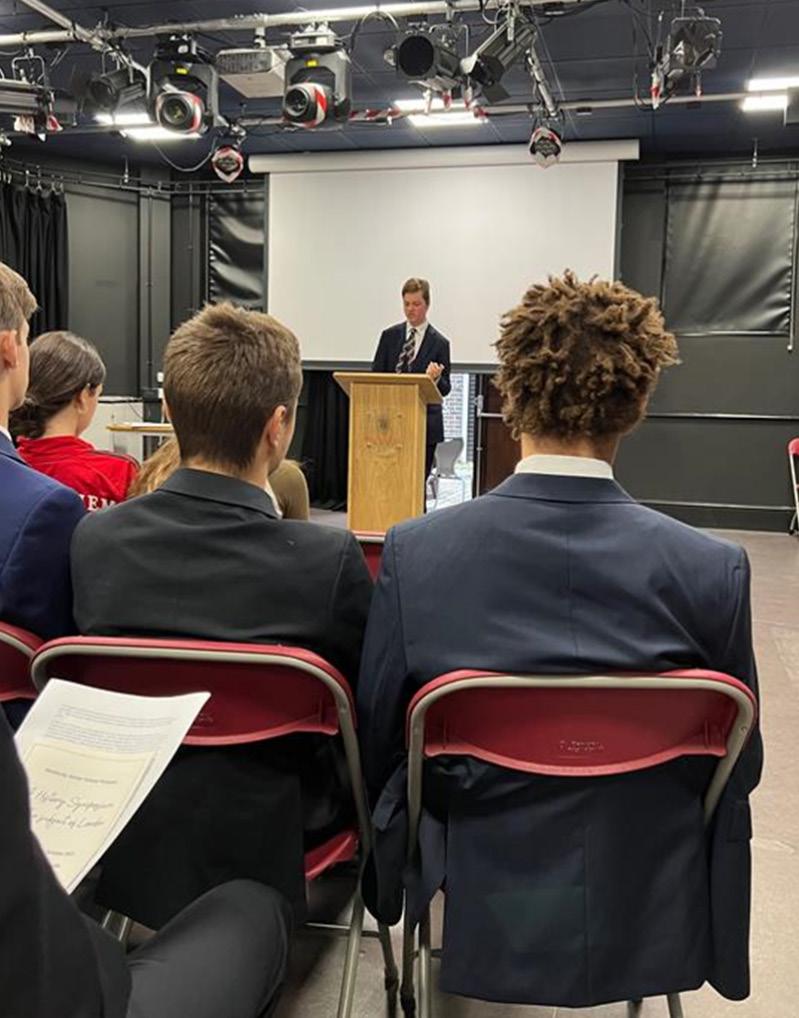
Isaac thoughtfully discussed how slavery in Marylebone was a pivotal factor in London’s economy in the eighteeenth century, and how many of the houses owned were by slave owners, sometimes accumulating up to ten homes.
Alongside this, both schools gave Year 13 a chance to research this period from 15ad Rome to the cholera outbreak of 1864, which had similar characteristics to the Covid outbreak we are still experiencing. Two presentations which stood out came from a Wetherby Senior prefect, Theo W, on how the evolution of Londinium came to be during the Roman Empire (did you know, at around 60AD, Boudica, a famous Celtic queen, nearly destroyed Londinium, killing over 70,000 men and women!), and a Queen’s College sixth former, Annabelle, who gave a presentation on the characteristics of the cholera outbreak and the drastic effects it had on London’s population.
Both Wetherby Senior and Queen’s College presented wellthought topics on the history of London and this symposium would not have been possible without Miss Mendes, Dr Poleg and Isaac Crichlow taking time out of their busy days, so we could listen and grasp a detailed understanding of the history of London!
EXPERIENCING A JAPANESE AUTUMN
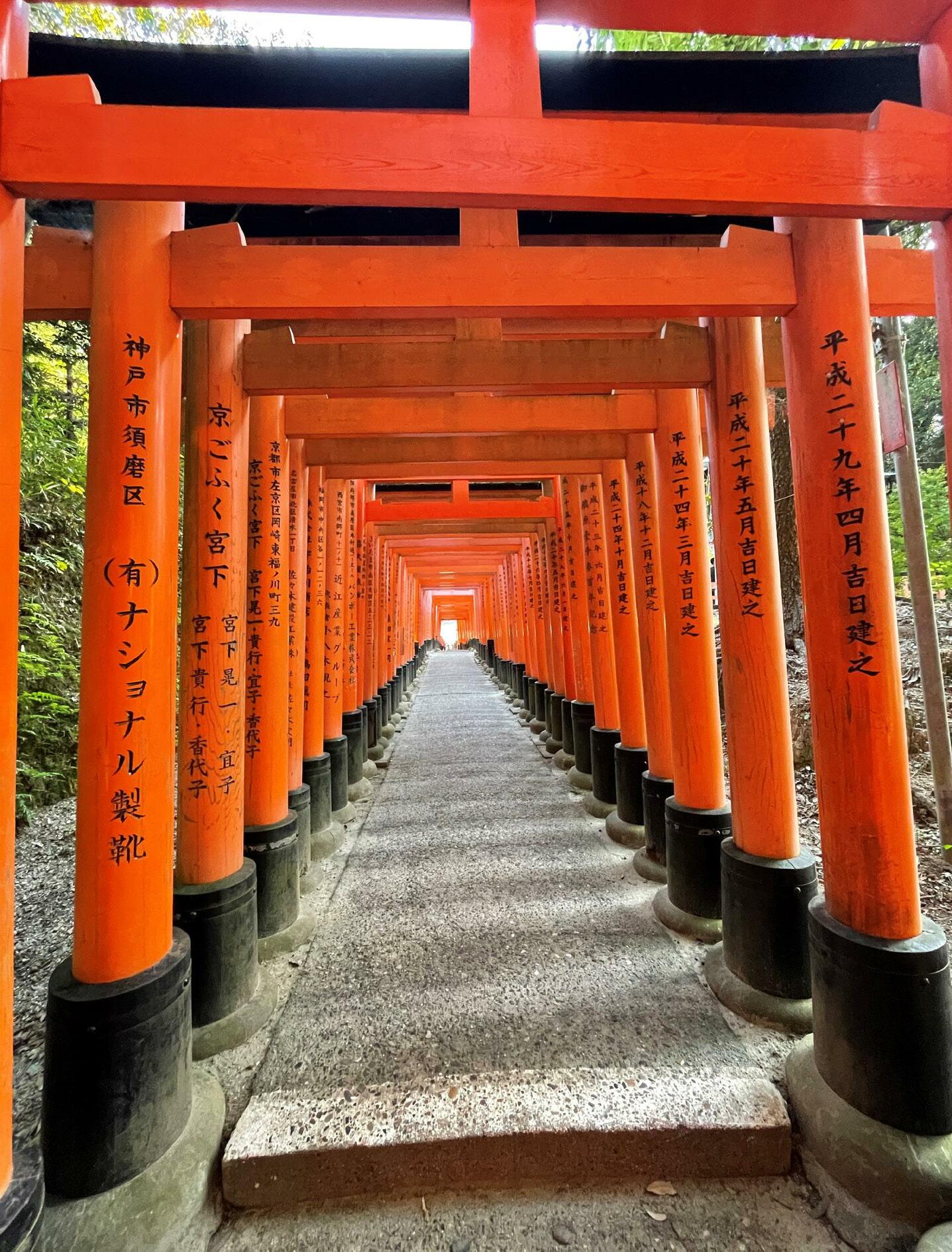 Mikey W, Year 7 writes...
Mikey W, Year 7 writes...
Japan’s restrictions for foreigners have been preventing tourists from entering their country since the beginning of the pandemic. Our plans to visit had been postponed four times in the last two and a half years. I could not believe our luck when, just four days before our scheduled flight, the Japanese government lifted visa requirements and we were able to go during our half-term break. It was odd to see that they still wear masks everywhere indoors, and most wear them outdoors as well.
Our first stop was Tokyo, a densely populated city with 35 million inhabitants, more than double the population of greater London. The Japanese capital is a blend of history and tradition with modern technology and architecture. From our hotel room, on the 47th floor, we had an incredible view all the way to Mount Fuji. In Shibuya, a central part of town, there is a famous five-way crossing where up to 3,000 people cross at any single time during rush hour.
It is impossible to eat badly in Tokyo when even the simplest restaurant with ten seats will serve you food worth a Michelin star. We visited the fish market, art
installations, busy shopping streets and temples. The funniest part was that, during our visit to the Sensoji Temple, we got interviewed by a TV crew for the evening news talking about tourism opening up in Japan!

After a quick stop in Hakone to enjoy the hot springs, we took the Shinkansen (aka The Bullet Train) to Kyoto. This train is considered the fastest and safest in the world, due to its aerodynamic shape. It has 56 electric motors powering over 100 steel wheels, 128 brakes, and can reach up to 200mph within three minutes. We
later travelled from Hiroshima to Tokyo (a 900km/560 miles distance) in just under four hours.
Kyoto, the original capital of Japan, is full of old Japanese culture. It was incredibly interesting because we visited many temples and shrines. Some belonged to the Shogun, who was the leader of the Samurai fighters until the late 1800s. The Rokuonji Temple was built and covered in gold to the brim. We also visited a monkey park and bamboo forest. Kyoto has a two very busy markets full of food stands and souvenir shops. Nishiki Market was my
favourite one. We did a Taiko drumming lesson (also known as Japanese drumming) which was not as easy as it looked. Another fun activity was sushi making. I learnt that the secret of good sushi is Dashi (dried fish broth) which in its original form is literally as hard as wood.
After another fun ride on the Shinkansen, we arrived in Hiroshima. This town became world famous for all the wrong reasons. On 6th August 1945, at 8:15am, a nuclear bomb was dropped here by the US Air Force. We spent our first day in Hiroshima visiting the Peace Museum and the many memorials across the city including the eternal flame of peace, the origami peace art made by children, the hypocentre (where the bomb exploded 600m in the air), and the last standing building from the bomb, which was a theatre. I felt really sad realising that humans are capable of doing such
a horrible thing. On our second day, we had a tour guide who survived the bomb. She shared her family’s story. She was so kind that, in the afternoon, she invited us to her home for a traditional tea ceremony. They had a special room laid out with tatami straw mats. She put on a Kimono (traditional Japanese dress) and talked us through the ceremony.
The tea was very bitter but she served us some sweet matcha cake to balance the bitterness. Japanese people are very kind, but we were surprised to be invited into someone’s home.
This was an excellent trip with lots of new experiences. I learned a lot about the culture and Japanese people.

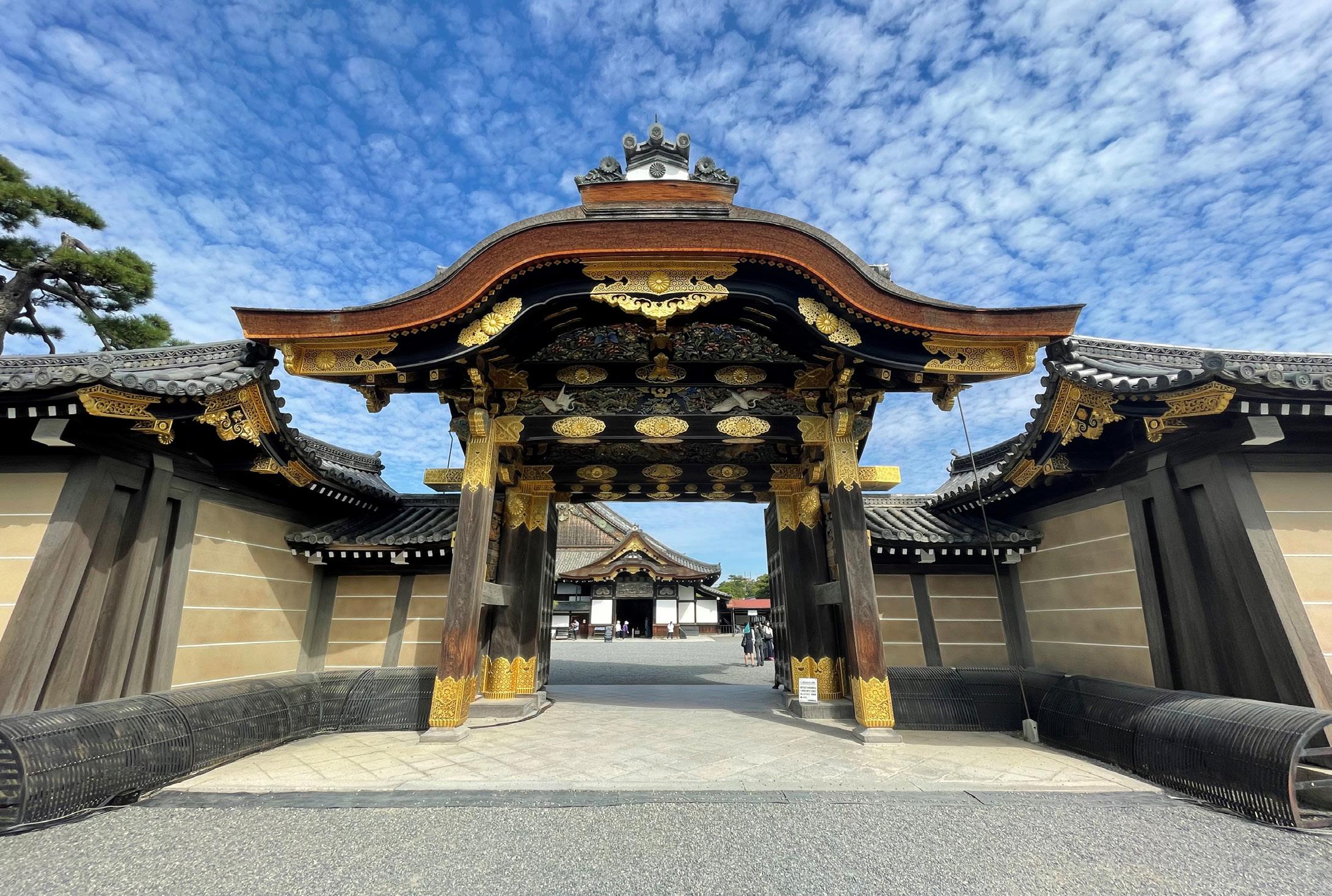
REVIEW OF THE MID-TERM ELECTIONS
Felipe E, Year 8 writes...
The Democrats came into the night with low hopes, but went on to do better than expected. Whilst Republicans have been projected to take the House, their majority will be less than ten seats meaning McCarthy has a tough job come January. The Freedom Caucus, who are to the right of the party, will want concessions. However, there are Republicans who won in Biden districts of +10/15 points, so it would be not be a smart decision as this would make it easy for the Democrat running against them, in 2024, to label them as an extreme Republican. McCarthy has said that he will ban proxy votes when he becomes Speaker of the House, which I believe is a bad thing as, when your majority is so small, you need every vote you can get.
The Democrats have kept the Senate which means Biden will be able to confirm his judges and cabinet. Biden can continue with a lot of governing even if the House is Republican. This means that, if another vacancy on the Supreme Court comes up, then Republicans have no way to stop them from confirming their judge. Networks were able to call the Senate after Catherine Cortez Masto, who was running for re-election in Nevada, won her race. Democrats also picked up a seat in Pennsylvania, meaning that, if they win the run-off in Georgia, then they will have a complete working majority without having to have the VicePresident break every tied vote. This also sets up an area where Manchin or Sinema can block Democratic Cabinet or judicial
appointments without holding their party to ransom. Now that they have this complete working majority, Democrats also have a majority on committees meaning that they can vote senators out of committee, without having them to go to the floor, thus wasting precious floor time where they would be able to pass other bills. One thing that Republicans could have easily avoided was having bad candidates. Blake Masters in Arizona, Herschel Walker in Georgia, amongst many others. Many of Mitch McConnell’s worries held up on election night, with a lot of election deniers ending up losing their races.
Another focus was governor offices and secretary of states, as these officials would be deciding whether to certify the 2024 elections in their state or change them. Democrats did particularly well in these races, as people were tired of lies and election denialism. Scott Jennings, a former staffer in George Bush’s administration, said that the people want their priorities acted upon, not some lies about something two years ago. Democrats won in Kansas, in a year where there were supposed to be very fierce political headwinds. Trump won the state by fifteen points in 2020, so this was expected to be an extremely hard race for Laura Kelly to win. Yet she won the race by 2%, which shows that she was extremely popular in the state. Democrats also won governor’s races in Michigan, Pennsylvania, Minnesota, Wisconsin and, potentially, Arizona, as votes are still being tallied. They lost in Nevada, but
the race was an extremely hard for Democrats to win, as the state had the highest unemployment rate in the country. They lost the governors mansion in that state but the legislature is democratic, so it is not too worrying for Democrats there. Democrats won two key statewide races in Arizona - the Governor and the Secretary of State meaning that, come 2024, the race there is not endangered by a Trump Republican messing everything up.
One reason Democrats did so well was the outsized influence of Trump in all these races. Governor Larry Hogan of Maryland said that election night could have been a good night for the Republicans had Trump not had the influence that he did. He said: “Three strikes and you’re out.” A lot of people in the Republican party have called for Trump’s influence in the party to be reduced but there is an issue that, because a huge portion of the party is united behind Trump, alienating him in the party means you take a substantial number of the party’s votes away.
A scenario on an online website gave me Biden winning because you are splitting up the Republican vote, making it near impossible for either of the two sections of the conservative movement to be able to win. Democrats would relish this opportunity as the conservatives would be split up, meaning that they would have a chance in areas where the conservative movement is at it is strongest. This would be truly extraordinary.
A COMPREHENSIVE
The attack on Denmark on 9th April 1940 lasted a matter of hours. Only 13 Danish soldiers fell in combat and, by 8.30 am, Danes were waking up to swastikas flying and life under the Nazi regime. They had a choice to get on with their lives as before or to fight back and resist.
Deep underground in Copenhagen is the newly opened Museum of Danish Resistance, an interactive venue that tells the story of the most effective resistance movement in World War Two. During the five years that Denmark was under occupation, the Danish Resistance movement was arguably the largest and most disruptive to the Nazi war machine in Europe.
The occupation of Denmark was key to the German war plan, as it was used to provide food, raw materials and fuel to Germany. Danish farmers put food on the tables of German people and Danish companies supplied the German arms industry. From early days, the resistance movement went into action by sabotaging trains carrying goods leaving Denmark, blowing up their own railway lines and factories, protesting and civil disobedience in the streets. They even organised a general strike, behaviour that challenged the Nazi occupiers. When Hitler ordered the round up of Danish Jews in 1943, the resistance movement pulled off a spectacular feat. The Danes did not identify their Jewish population as anything more than Danes with another religion. Denmark is the only occupied
MUSEUM OF DANISH RESISTANCE
country in Europe that actively resisted the Nazi’s attempts to deport Jews and managed to save the lives of its Jewish population by organising the escape of around 8,000 Danish Jewish men, women and children to neutral Sweden, in the dead of night, on fishing boats.

These stories, and more, come to life at the museum, as you walk through the dark and shadowy streets of occupied Denmark, following the lives of six Danes during this period. All are from different social and political backgrounds, from the far left to the far right. Musse Hartig, a young mother and member of the communist party, who has to leave her children and go underground. Jørgen Kieler, a young medical student who joined a student group behind the underground newspaper and becomes a saboteur in the resistance movement, before being sent to a concentration camp. Thorkild Lund-Jensen, a young engineering student who has to go into hiding. Out on a mission in May 1945, one day before liberation, he was taken by surprise by a German patrol and killed while trying to escape. His parents never knew he was part of the resistance movement. Karl Christensen, who fought in the Spanish Civil War before becoming a Danish freedom fighter. A communist ,he blows up German friendly factories. Abraham Steinbock, who escapes the country in a fishing boat across the Oresund to Sweden, and Henning Brøndum, an active member of the Danish Nazi Party and member of the infamous Peter group. Amongst other things, he killed innocent Danes - the so-called clearing
murders. He also blew up buildings and infrastructure, all with the purpose of creating fear and terror among the population. Henning was executed in 1947.
The resistance struggle during World War Two is a chapter of Danish history which creates much debate, not just in how much influence did the resistance have on this period but on the difficult choices that the Danish people had to make. The choice of violence and resistance, and in contravention of law and order. It was a choice that would unfurl into devastating consequences and put peoples’ lives at stake.
Although the focus of the museum is on the Danish resistance struggle, the Museum of Danish Resistance also casts light on the political context of the period and the realities of everyday life under German occupation, and brings to life a very real period of history. The museum uses maps, photographs and personal letters to document the harsh struggle of the Danish resistance.
Woody F, Year 12 writes...
HOW LEARNING A NEW LANGUAGE DOES MORE THAN YOU THINK
Jonathan P, Year 10 writes...
Learning a second language promotes cognitive abilities such as intelligence and memory, which lowers the risk of dementia, brain aging, and Alzheimer’s, as well as making your brain healthy and fit.
Some people may think that learning a language is pointless, especially if you will rarely need it or even ever use it! However, learning a language does much more than you think, regardless of whether you need it or not.
Learning a language promotes concentration, cognitive ability, maintaining mental alertness, helps brain development, and improves memory. Playing brain training apps help your brain, but they cannot do what learning a second language can do for your brain.
Brain power is improved in several areas because the brain must absorb a complicated new system of grammar, vocabulary, and structure. Thinking in a new language, and being able to recognise and speak new forms of communication, is a challenge for the brain but, from this, we also develop efficient cognitive thinking and problem-solving skills. Critical thinking skills are important professionally and personally.
Neurologists have found that the more we utilise our brain, the less its functions fail. Learning a language is a rewarding endeavour for the brain. When learning a language, memory is activated, which then makes new neural connections when we alternate
from one language to another, like switching from English to French and vice versa. Functions such as calculation, language learning, and reasoning are strengthened. Learning a new language also promotes grey matter growth, which helps in processing information.

Learning a foreign language also enhances the brain’s abstraction, and comprehension. When learning new grammar and sentence structure, like in German, when putting the second verb to the end of the sentence, or in French, learning verb reflexives, makes us more aware of how language structure differentiates from others, which improves our grammatical awareness of our first language, like English.
Being able to switch between languages proficiently, and being bilingual, is very challenging for the brain. People that can juggle languages are shown to be much better at multitasking, which is very stressful for most, but this ability can reduce the stress of
multitasking. Multilinguals are also shown to be more efficient in problem-solving because the mind is sharpened to spot deceptive and misleading info.
Learning a new language takes motivation and drive, whether its learning Japanese to understand anime, attempting to understand a foreign language when you go abroad, throwing yourself into an entirely new culture, or just trying to improve your brain power. I recommend apps like Duolingo for a fun learning experience, Babbel if you want a traditional language learning experience, or Memrise for need to know vocab and phrases for GCSE!
Struggling to find motivation? Whether it’s just ten minutes during your free time or five minutes after dinner on the couch, building a long-term habit will keep you learning as it becomes a daily routine!
Keep learning new languages! Your brain will thank you!
WHY DATA COMPRESSION MATTERS
 Daniel W, Year 9 writes...
Daniel W, Year 9 writes...
As humanity’s library of endless knowledge keeps expanding with time, we are inevitably going to need to find methods to store it efficiently. The rapid string of signals for Morse code could be considered data compression because it assigns brief codes to characters in our alphabet. While Morse code is relegated today as a relic of the world wars, the compression of data is still valuable for space on our computer hard drives.
The ZIP file is a common way to reduce the space your files take up. It packages a bunch of your general files into one, which computer networks find easier to send between computers. Zip files are provided in almost any company or government agency environment, with the proliferation of computers storing records and data. The fact that we can certainly find zip files in our jobs and our free time on the web is a sign of a utility we can rely on.
Compression also finds use for more specific data, such as the data in images. Techniques of
image compression diverge into Lossless and Lossy. Lossless compression permits the retrieval of the original data from compressed data without compromising information and is suitable for detailed images. Lossy compression refers to the degradation of information in exchange for a more substantial reduction in data, that surpasses the results of Lossless through the manipulation of visual perception to achieve an image with a negligible loss of detail.
With the large volume of visual elements that comprise computer interfaces and websites, compression is critical for optimizing the speed they run at.
For digital audio, we see the implementation of codecs to interpret sound into digital signals which computers can receive and playback into sound with an audio decoder. Codecs can compress with Lossless and Lossy techniques, the most popular being Lossy as demonstrated by file formats like the MP3, which dominated online music distribution during an era of the internet where bandwith was a
luxury, and was supported on most portable media players at the time to adapt to their limited capacity.
For music streaming services, there is continuous communication with users and servers, which may result in some platforms compressing audio to compensate for insufficient bandwidth on the user’s end.
The videos we watch pose a perplexing issue for compression. We previously relied on physical media like magnetic tape in film to store them but, with the advent of CDs and DVDs which utilized digital storage, there needed to be a method to compress the large amount data. This was answered by the creation of the MPEG files, gathering many companies like LG, Panasonic, Sony and Mitsubishi electric to advance video compression technology, demonstrated by video distribution like Blu-Ray, YouTube, Netflix, Adobe Flash player and TV, which use MPEG-4.
With videos being more flexible on how much space they take up, their distribution is more accessible to the wider public and has allowed the preservation of film to exist outside the boundaries of physical media that may not be functional with the passage of time.
With the countless advancements in compressing data, it is evident of how much we march on to provide a world with access to media.
RESEARCHING LOCAL BUILDINGS: A STARTING POINT
Kaveh K, Year 11 writes...
Even if you, like me, didn’t choose history as a subject, it’s inevitable that you will at one point find an interesting building, street or person, and will want to know its context. In this guide, I’ll explain how to research a building’s history. Many of these steps can be done from the comfort of your armchair, but you should be prepared to visit archives, libraries, and other resources, if you want an in-depth analysis. Often, doing this research is much easier than you expected. First, let’s begin with an explanation of references and sources.
Books are the crème-de-la-crème of sources. Nothing beats the reliability and factual accuracy of a published, printed book. However, this comes with the price - some books can only be found with great difficulty, and some “lost” books cannot be found at all.
Magazines and newspapers are also useful, and can often be found on online archives, though some require subscription services.
Websites and blog posts can be a good starting point for research, but unless it is a website of generally high quality (eg Encyclopaedia Britannica, cited content from Wikipedia, etc) don’t outright copy information from them, as there may be inaccuracies.
Word of mouth: Use it as a starting point to find references for. Never use it on its own unless coming from a subject-matter expect (eg a historian) and you ensure it is clear it is a quotation (eg John Smith, X at Y believes…).
If you are struggling to come up with a topic to research, try and find something in your local area that seems to have an interesting history, but you don’t know much about. Often public service buildings are a good start, as they are generally well documented.

The first thing you should do, when you have chosen a topic, is type it into Google. Though you probably won’t find the best sources to use, Google, and especially Google Books, is a great place to find good leads and sources to follow up later. For
my example, I am researching Hampstead Central Library, so I’ll type this into Google Books in quotes, so only exact matches will be shown. I’ve deliberately chosen a more obscure topic, but try to choose something with more information available, if possible.
From my initial search, I learnt there were two different buildings with that name, and I’m looking for the pre-1964 building. I found a photo (right) and also discovered this building is now Camden Arts Centre. To only target books pre1964 I pressed the “Tools” button on the toolbar, then any time and entered a custom date range. After further refining, I learnt that the borough librarian in 1911 was a “Mr WE Doubleday”, and that it was struck by a high-explosive bomb which destroyed most of the library in 1941, according to a subject-matter periodical. I also researched the arts centre now housed there and found some additional information, such as the date it opened, who opened it etc.

Finding out what the current use of the building you’re researching is also important. I contacted Camden Arts Centre, describing my research, and a member of staff kindly sent me some resources they had on the building. I discovered an issue of a local history journal (right). This gave me a new periodical to follow up and research.
You may have been lucky and found an array of sources you can use or you may not have found a single one. No matter the result, there is always one source that will provide definitive information: maps.


Visit https://maps.nls.uk and click “side by side map viewer”, press “Swipe On”, and then click the checkbox in the middle-top of the screen labelled “only show maps with more detail”. Use the dropdown to switch between maps until you find one you like
and visit the area of interest. Now you can use the swipe divider to see compare the historical maps to current day satellite imagery.
In my case, I’ve learnt not much has changed, but many buildings (like Wetherby Senior itself, Half Term 3 2021-22) have changed significantly.
Finally, another method of research from your armchair is online reference resources.
Try looking up the name of your borough’s library network, followed by “online reference information” or “digital library”. Almost all library networks offer premium archival services, such as Ancestry, for free to patrons with a library card (which is a must have if you intend to further your research). For example, I was able to find some information on the library from Newsbank and The Times Digital Archive, which provides digitised versions of historical (and new) newspapers.
Next time we’ll look at more in-depth research using harder to find sources and libraries.
Arjun D, Year 12 writes...
Here is an immortal jellyfish!
Can we uncover how it is immortal from its genes?
Turritopsis dohrnii (T. Dohrnii) now becomes the only known species of animal that is able to live forever!
Prepare to take a glimpse into this real-life time traveller...
Who are these creatures? They are translucent and tiny, about the size of a small nut, which roam the Mediterranean Sea.
These teeny jellyfish, known as Turritopsis dohrnii, flap around their delicate tenticles consuming plankton.

Time reversal of T. dohrnii jellyfish

These jellyfish have a superpower ability to turn back time to become their younger selves. The Process is shown below:
1. Reduction: Mature adult jellyfish (medusas) turns into a circular blob by shedding old body mass, turning into a small sac.
2. Resting: The small sac become sedentary, like a drifting blob.
3. Growth: Like a tree growing leaves, the sedentary blob grows and tentacles appear.
4. Eventually, a young jellyfish sprouts from the sedentary blob
(polyp) and the jellyfish has now time travelled!
This process keeps repeating, so the jellyfish will never die of old age.
Fun fact!
Use of technology estimates approximately 17,468 genes (sections of DNA that codes for a specific protein) in the T. dohrnii (jellyfish) and about 390 million bases (part of gene).
How does T. Dohrnii turn into its younger self?
The key factors allowing this jellyfish to rejuvinate are its genes and proteins.
So many identical genes!
The jellyfish has thousands of copied genes! In fact, copied genes make up about half of its DNA. In particular, repeats of sections with lines of 7,000 dna bases are common. This helps repair and protect chromosonal tips of cells, which is important in the cells survival as DNA erodes over time.
ARJUN’s SCIENCE UPDATE
Genes (maintenance)
Two GAR1 genes were found in T. dohrnii jellyfish, while similar species have only one GAR1 gene. This increases efficiency of enzyme activity within the cell. Enzymes help repair tips of chromosomes which store genes. Overall, this is slowing the ageing process!
Proteins (maintenance)
These jellyfish have two unusual protein (shelterin) structures in their cells. These are surrounding the tips of chromosomes that store genes.
The enzyme (telomerase) and protein (shelterin) work together in age reversal. The telomerase is like a plumber, fixing the tips of chromosomes, while shelterin is like a soldier, protecting the tips from damage.

Teamwork of enzyme + protein action
The teamwork between enzymes and proteins mean there is less eroding of DNA, so these jellyfish
can continuously rejuvinate with a lower chance of a mutation happening (which would change the jellyfish’s appearance or behaviour).
However, the order and size of end sequence of chromosomes is the same as other organisms.
Smart genes
Different forms and bigger genes that are to do with copying, repair, maintenance and stable environment for the genes have been found.
In addition, genes that help start up of growth cells into mature forms.
Uncovering the mystery
Collecting enough jellyfish to study their genes is not that easy!
In fact, only one scientist, Shin Kubota, actually has a colony of these jellyfish in his lab in Tokyo, Japan.
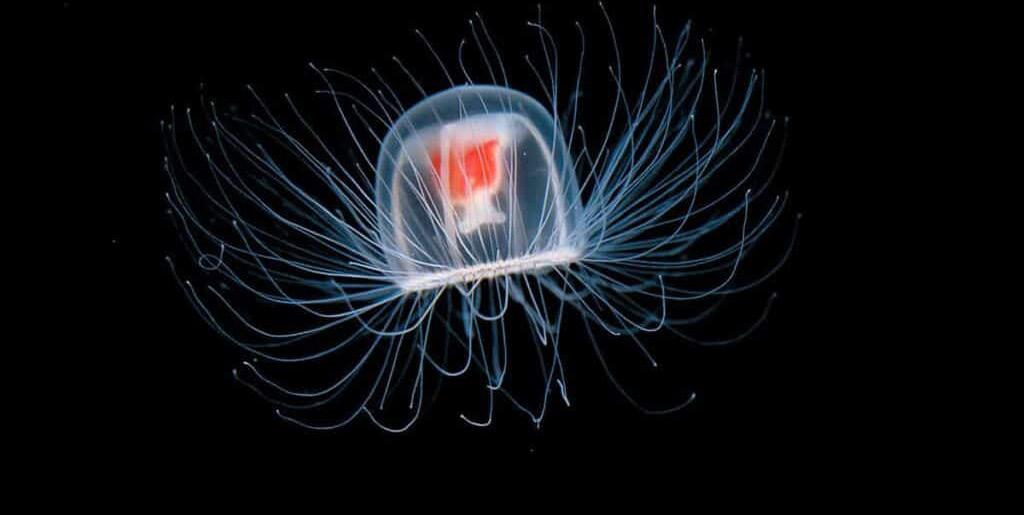
When trying to get data to make a paper, scientists used a special camper van and dived in a successful attempt to collect jellyfish from the Mediterranean Sea ,before rushing to the laboratory.
To observe the time reversal, the researchers took snapshots of mature adult T. Dohrnii as they become tiny blobs and started growing back again to a mature adult jellyfish (medusa).
The Big Question!
Is there some way we can make use of this process to delay the effects of ageing? Or to someday make us immortal?!
For the time being, this superpower is available only for jellyfish...
I’m sure we’ll catch up one day!
ARJUN’s SCIENCE UPDATE
Arjun D, Year 12 writes...
Big race to uncover mysterious banana ancestors has kicked off!
Crops - From wild to store. Some crops on earth are hybrids (cross-breeds) and domestication, in about the last 12,000 years, is because of humans and the environment
Bananas
Bananas are a naturally (propagated) crop, native to a wide South-East Asia/Oceania region. It was domesticated from wild bananas (Musa Acuminata) about 7,000 years ago, likely in New Guinea, Australia. Farmers wanted bananas that have a high ability of making a banana without fertilisation (parthenocarpy) and sterility which is a lack of seeds, ie ideal banana to grow = seedless + do not need pollination to reproduce.
Discovery: sci fi times!! Recent discoveries from studying small sets of bananas, grown in plantations, with pure wild bananas ancestry shows different ancestral genepools (variation of genes) contributing to the setup of farmed bananas (cultivars. These are missing in the wild banana diversity.
So, in total, three banana ancestors are not known to us! Some affected bananas are grown in South-East Asia, Borneo and New Guinea!!
What we know:
1. Wild bananas (Musa Acuminata) existed about 10 million years ago, likely Indo-Burma region, Bangladesh.
2. Four parts of species: ssp. burmannica/siamea (southern India) ssp. malaccensis (Malayan peninsula) ssp. zebrina (Java) and ssp. (Philippines) contributed to genetic makeup of modern storebought bananas
3. Wild bananas found in East India, Sri Lanka, Papua New Guinea and Australia. The New Guinea bananas (subspecies M. acuminata ssp. banksii) helped in the domestication of bananas and are widely thought of as the genepool (different genes) of modern bananas.

How do we know about the new genes etc?
Scientists studied changes in the nucleotides (parts of DNA) of different bananas. Analysis of 226 bananas discovered 158 (gene combinations) genotypes and 132 unique (new) genotypes (combinations)!
Studies showed mysterious variations of DNA in wild bananas. There were two records from Thailand that have some genes from the species (ssp. burmannica/siamea) in their DNA (genome) but also the genetic makeup estimated for ‘truncata’ and ‘sumatrana’ bananas of the same subspecies showed different genepools (genetic variation) with a type of gene (malaccensis) dominance in both. Both have different genetic profiles so both have different characteristics, eg one may be bigger.
What are the main factors in banana domestication and why is this research is important? Factors affecting banana domestication (and most other
crops):
1. Hybridisation - When bananas (or other plants/animals) breed with members of different species/ varieties
2. Introgressions - Transfer of genes from one organism to another by either hybridisation or breeding of bananas (plants/ animals) with another organism of the same genetic info.
Most world banana plantations, especially in Africa and Central America, only grow the subspecies cavendish. Safe? Science says not!
Although the cavendish is the most eaten variety because of multiple factors (eg sweetness, texture etc), having the majority of bananas bred from one species is risky, as the low genetic diversity of banana makes them too easy to all be affected by fungal outbreak or disease.
So, we hope research like this can help make more diverse, adaptable bananas by more cross-breeding.
Mysteries still itching to be discovered!
How can we make our bananas more genetically diverse?
How else can gene technology help us understand the evolution of modern day crops (eg pineapple)?
What is the full wild banana genepool (gene variation) and how can we use that to make better bananas (eg more resistant to disease)?
Tyler B, Year 12 writes...
What are they?
Microplastics are tiny plastic particles (roughly around 0.2 inches) that come from both commercial product development and the breakdown of larger products. As a pollutant microplastics can be very harmful to the environment, which can result in a disruption of food webs.
Primary and secondary?
Primary microplastics are tiny particles that are used in commercial use, such as cosmetics, with the addition of microfibers which can be found on clothing and other textiles such as fishing nets. Secondary microplastics are particles that have been broken down from much larger pieces of plastic like water bottles. Therefore, microplastics are being digested by everyone daily as it is very difficult
to see and very easy to digest.
The problems of microplastic?

One of the main problems with plastic, in general, is the fact they take hundreds to thousands of years to decompose, which means microplastic would remain for many years and often finds its way into our food in the form of marine animals, which digest large quantities of microplastics. Microplastics can be found in a wide range of animals, as even the smallest, like phytoplankton, contain these harmful microscopic plastics and so do much greater animals, such as whales, which carry large volumes of microplastic.
Can it be harmful to humans ?
The consumption of microplastics at high exposure can lead to poisonous effects within the human body. However, a main worry of microplastics can be
MICROPLASTICS
how it can be found within lung tissue, as humans can be exposed to microplastics due to breathing it in, which may cause multiple problems within the future for humans as more plastic is being digested. In addition to this, many manufacturers add compounds such as plasticizers, stabilisers and pigments to plastic, which can interfere with the hormone systems within the body.
Furthermore, if the microplastics are small enough to enter tissue within the body, it can lead to irritation and, possibly, cancer.
Microplastics in blood?
Very recently, scientists found microplastic within a human’s blood for the first time. While it is unknown what the effects of this could be, it is suggested by many that this may affect how much oxygen we can carry around the body. This may lead to respiratory problems, which could perhaps even lead to death.
Stepan K, Year 13 writes...
In the 1950s, this new airliner is the pride of the Soviet Union. A sleek new airline, one of the first ever to be powered by jets, it flies faster and further, and showcases Soviet technology. However, there’s something wrong with this plane because, over a few months, airliners like this one have been involved in a bizarre string of incidents. These planes aren’t just crashing through but being thrown up into the sky, sometimes by several thousand feet, leaving investigators racing for answers.
The 1950s saw the start of a boom in commercial air travel. Flying had become safer, faster and more comfortable, and those who had the means could now cross entire continents in just hours, or travel halfway around the world in less than a day. Air travel had entered a golden age, at least in the western world, because over in the Soviet Union, flying was radically different. Soviet airliners were at least a generation or two behind western designs; they were slower, smaller, and offered little comfort. They couldn’t fly very far and, in a country as massive as the Soviet Union, that was a problem, since flying across the country, from
Moscow to Vladivostok, meant having to stop to refuel at least six times. The trip could take as long as 50 hours, and it was even more gruelling aboard cramped and noisy aircraft that couldn’t fly high enough to avoid rough weather. In the early 1950s, the Soviet Union desperately needed a new modern airliner but, rather than just catching up to the West, they were about to make a massive gamble on new technology.
In 1952 the British stunned the world by introducing the first ever jet-powered airliner, the De Havilland Comet flute, nearly twice as fast as any airliner before it and travelling 15,000 feet higher. Developing it had been a massive effort, requiring years of research and development. While jet engines were still relatively new and unproven, many could see that they were the next evolution in air travel, including one famous aircraft designer from the Soviet Union named Andre Tupolev. He saw them as a way to bring Soviet air travel into the future. A jet airliner like the Comet could cut flying times down by a third and enable air travel on a mass scale. The problem was Soviet leadership saw jets as unreliable, fuel-thirsty, and expensive.
Moreover, the Comet had taken the better part of ten years and millions to develop - time and resources that Soviet leaders weren’t eager to invest. Knowing thism Tupolev came up with a plan. He promised the top Soviet brass that he could build them a jet in just three years, a reliable jet airliner with even more passenger capacity than the Comet, built at a fraction of the cost. What’s more, a
Soviet-designed jet airliner would prove to the world that the Soviet Union was every bit as advanced as the West. It was an offer they couldn’t refuse.

In order to build a jet airliner rivalling the Comet. in just three years, the Soviets took a massive shortcut, taking the Tu-16 bomber built to rain havoc over Europe. The airliner was designed in record time and built at a fraction of the cost compared to the Comet. Having just finished designing it for the Soviet Air Force, Tupolev figured he was already halfway there. He could keep the engines, even if they weren’t the most efficient, reusing the wings and widening the fuselage. The same was for the tail, vertical stabilisers, landing and avionics.
When Tupolev was putting on the finishing touches on his new plane, it became apparent that the transition to jet travel would be more complex. By 1954, design flaws in the Comet caused a series of tragic crashes, ultimately leading to the aircraft’s grounding. The Comet was banned from commercial flights for four years while investigators sorted out the issues. It meant, by the time, the Soviet Union’s new jet airliner made its first test flight in June of 1955, the Soviets suddenly found themselves with the world’s only operational jet airliner. However, rather than taking it as a sign

THE STORY OF THE TU-104
of caution, they jumped on the propaganda opportunity while the Tu-104 was still undergoing flight testing. In 1956, a delegation of Soviet leaders flew aboard the new plane to Britain. This rakish-looking airliner caught many off guards, and aviation experts and British news reporters still reeling from the Comet’s grounding kicked into a frenzy. Over the coming months, the Tu-104 visited cities across Europe and, each time, crowds greeted the aircraft and dignitaries were allowed to marvel at Soviet technology. The press was convinced that the Soviets had leapfrogged years ahead of the West with a much larger and technologically superior design. For the Soviets, it was a propaganda windfall, and it wouldn’t be the last time they showed off the new jet. Soon the first signs of trouble were already beginning to appear.

Compared to other airliners, the Tu-104 was a handful to fly. Pilots complained about heavy unresponsive controls and the aircraft’s enormous, carefully swept wings made low-speed flying particularly challenging. Landing at busy civilian airports was a white-knuckle affair. Pilots were so afraid of stalling it was common to practise landing the plane at higher speeds than designed. Stopping was another issue. The airliner had no air brakes, thrust reversers, and a weak set of wheel brakes. A hastily diploid parachute was often the only thing that kept the aircraft from continuing past the runway,

but Soviet authorities brushed off the complaints.
In 1958, the airliner began exhibiting behaviours that were impossible to ignore. The first sign of trouble came in February, when a Tu-104 flew into turbulence which caused both engines to flame out. The aircraft fell 20,000 feet without power before the frantic pilots restarted the engines. A month later, another 104 ran into turbulent weather, but this time the aircraft was hurled up into the sky, and the pilots couldn’t stop it from climbing up to 44,000 feet higher than the plane should ever fly. Eventually, the aircraft sttalled and began tumbling back to earth before the pilots regained control. Despite these near disasters, Soviet authorities were quick to blame the pilots but the incidents continued. In August, another Tu-104 was mysteriously hurled up into the sky again; the aircraft stalled but, this time, the pilots couldn’t recover, and tragically there were no survivors. Two months later, a 104 flying between Beijing and Moscow was hurled again into the sky; this time, the pilot heroically radioed back details as they were happening. While he couldn’t save the aircraft, the information he provided would prove pivotal. Authorities could no longer ignore the bizarre series of accidents. There was something wrong with the plane. Remarkably, however, they wouldn’t ground the aircraft, instead letting it continue carrying passengers while still working to uncover the mystery.
Eventually, investigators would realise that the cause was powerful updrafts that the pilots couldn’t counteract, and the aircraft’s bomber-derived origins were at least partly to blame. The
Tu-104’s larger cabin was prone to having its centre of gravity shifted rearward, depending on how the plane was loaded. This meant there was a natural tendency to pitch upwards, and the aircraft stabilisers weren’t powerful enough to counteract these forces, leaving the pilots helpless. Several emergency modifications were made to the aircraft, and it was restricted from flying above a certain altitude.
A critical design flow had cost 144 lives and, although fixes were made, the aircraft would still earn an extensive rap sheet of other accidents. The most common were runway overshoots, thanks to the tricky nature of flying. Nearly one out of every five Tu-104 built would end up destroyed in accidents but, given the secretive nature of the Soviet Union, these incidents received little news coverage.
By 1958, the Comet had been heavily redesigned and was back in service. The Americans had introduced their jet airliner, and any propaganda value the Tu-104 once had was gone. Nevertheless, the Soviet Union’s first jet airliner played a vital role in modernising air travel inside the country. Air traffic control systems were updated to accommodate the jet, new terminals were built, and runways throughout the Soviet Union were lengthened. The lessons learned from operating the 104 would help pave the way for future Soviet airliners, earning the Tu-104 a spot amongst the world’s pioneering aircraft.
Frederik B, Year 8 writes...
I am a sailor and I love sailing small dinghies in harbours outside of London. I fell in love with the sport two years ago and, since then, I have entered races, won competitions, and enjoyed being out on the water. I sail a topper- class boat, a 3-metre dinghy with a 5.2 m2 sail. I am mentioning this because the Comanche sailing boat is like mine, just a bit bigger… 11 times bigger.

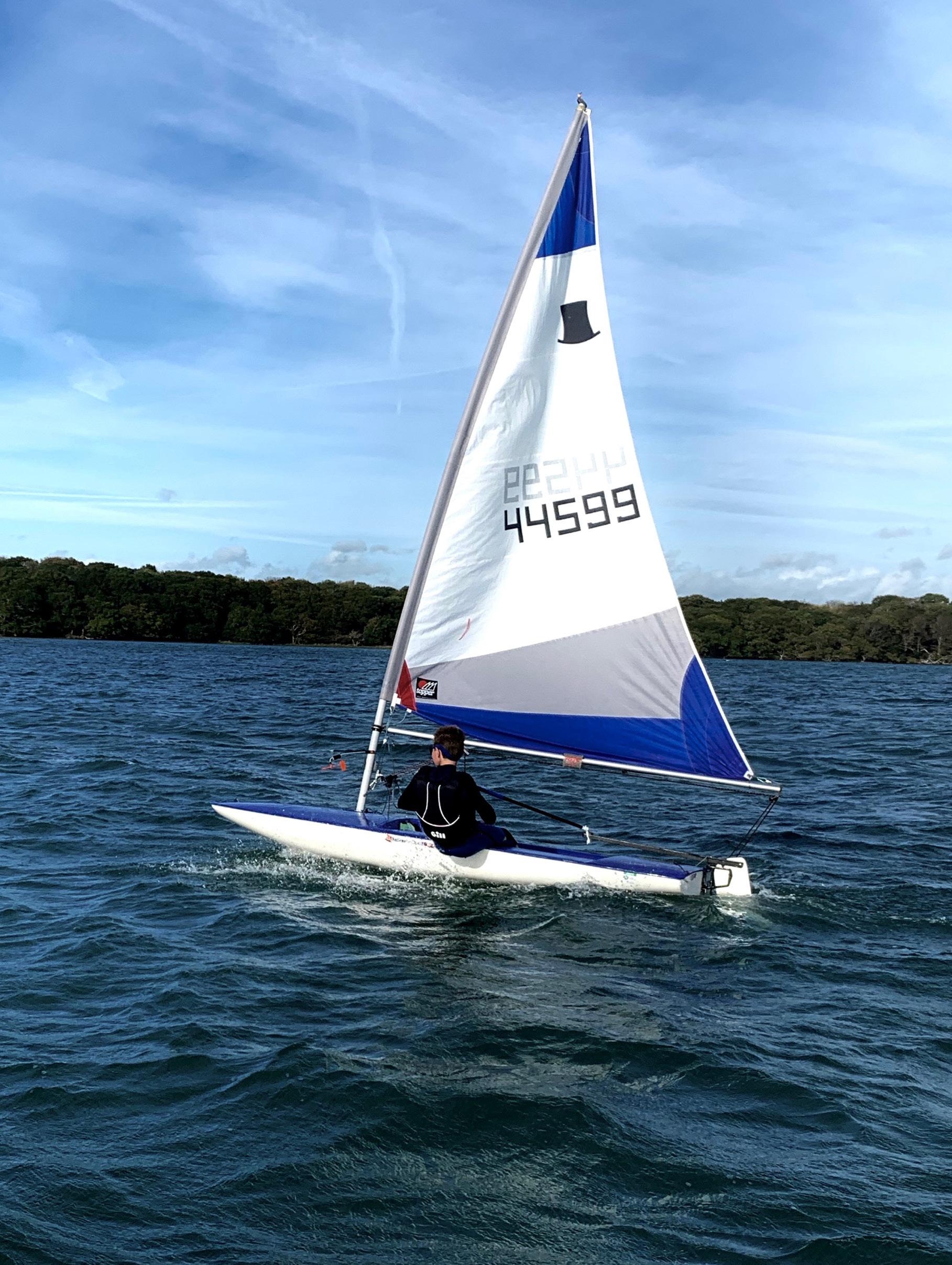
The Comanche sailing yacht has broken many sailing world records
and taken part in countless races, most infamous of them all being the record monohull transatlantic stretch. The Comanche smashed the monohull record by completing the eastward race from Ambrose light of New York to an imaginary line linking Lizard point in Cornwall to Ushant, which is around 2,880 nautical miles (5,330 km; 3,310 mi) on 28th July 2016, beating the previous time by 27 hours, with the new record time being set to 5 days, 14 hours, 21 minutes, and 25 seconds, averaging a speed of 20.2 knots.
James H Clark, an Texas-born billionaire who made his money in tech companies, wanted to create a superfast, 100ft sailing yacht that could break world records. What makes the Comanche such an engineering masterpiece is that there was no monetary limit, meaning that it is not a stingy build like many other such yachts. Regarding equipment, it is the best of the best. When Clark wanted the yacht built, he gave the French designers, VPLP, a very clear instruction - build the fastest possible boat that was legal to enter the major ocean races around the world. Did it work? It sure did. Hodgdon yachts built the 100-million-dollar masterpiece in a year and, in September 2014, incredible sailors like Ken Read and Casey Smith could sail this masterpiece.
In December 2017, after the Comanche had lived its short life by winning virtually any race it entered, the yacht was sold to an Australian, Jim Cooney, who had the same intentions as Clark. For now, the boat rests in Sydney, Australia.
COMANCHE SAILING
To say that the Comanche is the best monohull Supermaxi 100 sailing yacht would be right… and wrong, because the class that Comanche is in is incredibly specific and stupidly complex. This is necessary to make races fair. Anyway, I said that the Comanche is not the best sailing yacht in some ways because there are other, very capable sailing yachts, such as Alex Thomson’s Hugo Boss which is a boat with incredible technology and potential. However, it is better known for its sailor, Alex Thomson.

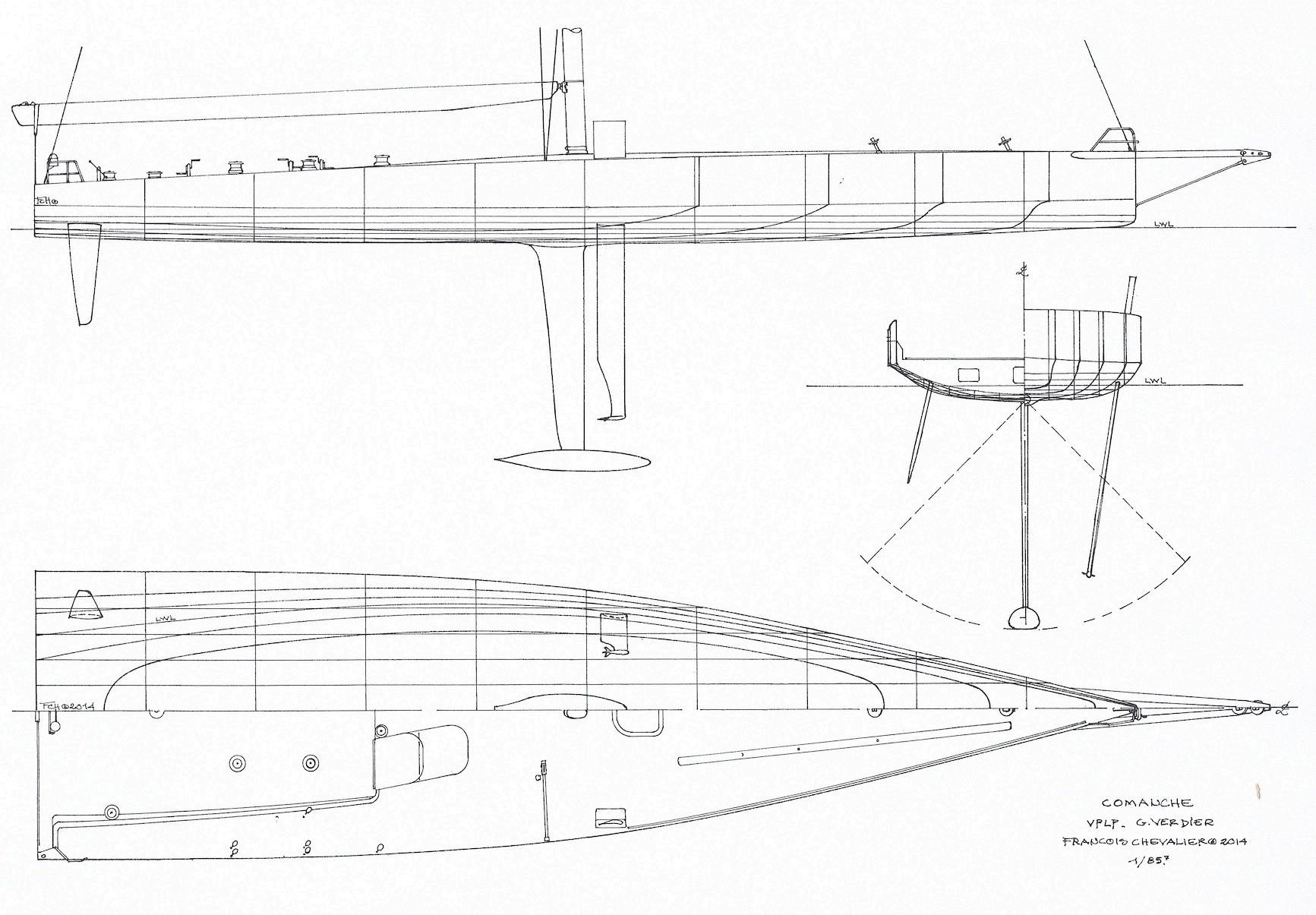
Alex Thomson is a Welsh-British sailor who entered the round-the-world clipper race in 1999 and was the youngest sailor to complete it. He won the race and the record he set 23 years ago still stands - there has never been a faster completion. It was in 2005, when Hugo Boss gave him his yachts, and Thomson still breaks records in them to this day (it is probably worth mentioning that, most of the time Thomson has sailed in this Hugo Boss, something always seems to go wrong. I would say that has more to do with the ocean conditions, not the sailor or boat). Thomson is also known for the stunts he does on the yacht - he has done the mast walk, where he walked up the sail when the boat was leaning; he stood on the keel in a suit, when the boat was leaning; and, while the boat was foiling (flying out of the water), he stood on the foiling wing and posed in a suit. He is also the man that you see on any Hugo Boss advert with a sailing yacht in it.
A sailing yacht is only validated if it is, in simple terms, good. This is unlike cars or watches, I would like to think that, in those sectors, something is already made with value but a sailing boat must earn
its value. In the Comanche’s case, it was only worth what it is today after it broke the records and it did this with incredible engineering.
The Comanche was expensive. It was 100 million USD to build and design but one thing that made it so expensive was that its hull is made entirely of carbon fibre and titanium, to make it light. On the design and technological side, the yacht has been called the ‘aircraft carrier’ because it is so wide (beamy) - this is so, when
the boat leans leeward (away from the wind), it will hover above the water. The yacht also has a vertical bow. This is to maximise boat length and maximise how much of it is in water, since the amount of boat in water is directly proportional to speed in water. Finally, the yacht has a keel that moves from side to side, this is so the boat’s centre of mass can be changed to get a flatter boat on the water because, as the old sailing saying goes: “a flat boat is a fast boat”.
The Barbarians (Baa-Baas) vs All blacks
Andrew H, Year 12 writes...
The Barbarian rugby team was formed by William Percy Carpmael in 1890. He had played rugby at Cambridge university.
The Barbarians are a Britishbased invitational rugby union club with some of the greatest players from around the world. The team has players from Southern Hemisphere countries, including Fiji, Tonga and New Zealand, and from theNorthern Hemisphere, including Scotland, France, England and Wales.
The Barbarians usually play six matches a year and, since 1890, have played in 25 different countries with over 70 games against clubs and international teams that showcase rugby around the world. They especially like to include smaller ‘rugby’ nations like Georgia, Spain and Portugal.
The Barbarians are unique, with players invited to join after selection by a panel of officials who choose the final team. Invited players are also allowed to take to the pitch in their own club socks. Barbarians are often a fun and unique team to watch as they may come up with unusual set pieces Line-outs, scrums and managers even allow players to play in positions they don’t normally play in. An example was Joe Marler. A prop, often the largest player on the pitch who tries to barge through opposition, he was seen kicking the ball and stepping the All Blacks defence.
I recently watched the Barbarians vs All Blacks XV at the Tottenham Hotspur stadium at White Hart
Lane. The moment I disembarked from the tube to walk to the Stadium, an overwhelming buzz flew through the air. A group of elderly men wearing barbarians jerseys slowly walked ahead, giving the whole of Tottenham a dire rendition of Swing Low, Sweet Chariot, only to be outsung by All Black supporters singing their New Zealand songs. Two minutes before kick off, the All Blacks preformed their intense, spine-tingling Haka, aimed at intimidating the Barbarians and spectators in the stadium. Then the referees’ whistle blew, the ball launched into the air, and the first crunching hit was made.
For the first eight minutes, the game went back and forth. The All Blacks were 5-0 up but a player was lost due to not releasing the ball when making a tackle. Minutes later, the Barbarians capitalised through brute force from a scrum, making it 7-5 to the Baa-Baas. The game continually went back and forth, momentum shifting every few minutes, with the All Blacks and Baa-baas trading the lead. When 40 minutes were up, the referee blew for half-time and the Baa-baas were leading 21-17.

After a quick ten minutes to grab a bite to eat and reflect on the intense and turbulent first half, the second half began. Further crunching tackles were made. The All Blacks were then the first to draw blood, running in a beautifully created try only four minutes into the half. The team talk at half-time seemed to have reenergised the All Blacks, causing
the Barbarians to make mistakes and give penalties away. However, due to excellent play with the Baa-baas full back’s grubber kick (kicking the ball along the ground) allowing the wingers to make a beautiful chip with the outside centre’s chase and offload, it meant the Baa-Baas to regained the lead with 28-24.
Wtih 20 minutes left, the All Blacks then spurned a glorious chance to take the lead, receiving another yellow card when the full back took a player without the ball, and the Barbarians further stretched their lead to 35-24. In the 71st minute, the All Blacks hit back through the winger, winning the race to the try-line making it 35-31. The 78th minute ticked by on the scoreboard, 2 minutes till the match finished. The All Blacks had an attacking line-out to win the game. The only thing they had to do was retain possession and score a try to win the match. However, it is easier “said than done” and the Barbarians stole the ball in the line-out using their forwards - the bigger players - to grind the time down until it went past the 80th minute into overtime. The ball was kicked out with the Barbarians beating the All Black XV to retain the Killik Cup. A great match!
If you like cricket, or England sports teams, or both, then this is the article for you.
The Three Lions won the coin toss and decided to bowl. England won the first match vs Pakistan on Monday after getting an impressive 159 runs they turned round and won by six wickets. Alex Hales surprisingly did not get out. So, England led 1-0 vs Pakistan on Monday. England and Alex Hales were delighted.
The next T20, Pakistan fought back hard to level it up to 1-1. Pakistan were fantastic in both batting and bowling. England struggled with the bowling and found it hard to get wickets. Pakistan celebrated, as England sulked.
In the third match of the series, on Friday, England won by 63 runs, after getting an incredibly good 221. Pakistan only got 158. The bowling was amazing and they got eight wickets in 158 bowls. England were back in front and happy again, but the battle was not over just yet.
Pakistan managed to level the tie by just six runs on Sunday! Pakistan got 166, when England got 163. Mohmand Ritzman got an excellent 88 runs from 67 runs. Also, Baber Azam got 36 runs, from a grand total of 28 bowls.
Pakistan had levelled the tie again and England were, one more, frustrated, since they were only
vs
three runs away from a possible victory.
On Tuesday, England were frustrated again. They lost by just six runs. This made the tie 3-2 to Pakistan. Pakistan got 145 runs and England got 139 runs. This meant that, if Pakistan won the next match, they would have won. England had to win.
On Thursday, England won by eight wickets. Pakistan got 169 and England got 170. Philip Salt was the man of the match for England, as he had stayed in since the beginning! The tie was now 3-3 and so, whoever won the next match, would win altogether.
For the final match of the series, England got the win by 67 runs. England got 207 runs when Pakistan got 140.

England had won the T20 against Pakistan in September 2022.
 Sebastian H-H, Year 9 writes...
Sebastian H-H, Year 9 writes...
PAKISTAN T20
ENGLAND
Stepan
K,
Year 13 writes...
At Wetherby Senior, there are many clubs, from barbel club to chess. However, I would like to talk about a small niche clubMotorsport Club. My friend Chris T and I have been thinking about starting a club for a long time together and, wWith the recent rise in F1, due to the popular Netflix series Drive to Survive, this seemed a great time to start the club. Additionally, the process of starting it was very easy. - we had to ask Ms Walters for permission
and then work out the logistics, So, to any others in Year 12, I recommend finding something you love and doing the same!
We have both been fascinated by the sport of F1 for a long time and have followed it very closely, even being fortunate enough to see a race in real life. So, at the beginning of Year 12, with assistance from Mr Knuckles and later upon his departure, we began to grow our club into a bit of a cult following. With enthusiastic fans ranging from Year 7 up to Year
13, it has been an unforgettable experience so far.
In joining the club, you can expect weekly discussions on any F1 topic and to watch races that are happening at the current time. This year, we have been on a steady streak of a seven members coming along each week.
We are seeking to grow in numbers so, if you are like F1 or are looking to explore it, feel free to sign up via Mrs Deedat at the start of the new term and reserve your spot on the grid line.

F1 NEWS AND DEBATE CLUB
SHOULD MICHAEL MASI HAVE BEEN SACKED?
Panos K, Year 9 writes...
Michael Masi, the Formula 1 Race Director, lost his job after the controversial 2021 Abu Dhabi Grand Prix, when Max Verstappen was crowned World Champion for the first time.

Seven-time World Champion, Lewis Hamilton, and Max Verstappen fought a very tough battle together throughout the 2021 Championship, with the two titans coming together resulting in races ending crashes on many occasions. Heading into Saudi Arabia for the penultimate round in the Championship, Hamilton grabbed pole position after Verstappen, who set two purple sectors, 0.3 tenths up on for lap of the season, hit the barriers on the final corner.
After a big shunt on laps 1-5, two red flags were brought out and the race suspended until repairment. Max Verstappen, on the restart jumped from third to first, leaving Ocon and Hamilton behind. Yet, not long after, Hamilton caught
up and tried to overtake the Red Dull when Verstappen missed his braking point and cut the corner. The FIA suggested that Verstappen give the position back to Mercedes or there would be a penalty. The Dutchman slowed down to give the position back but the Brit did not know, causing a collision leaving Hamilton worse off. The FIA deemed this a five-second penalty, costing Verstappen the victory. Already tensions were high between the FIA and the teams.
For the first time ever, two drivers had the same points heading into the final in Abu Dhabi. Verstappen started on pole, with Hamilton beside him. Yet Hamilton took the lead before turn one. From then, Hamilton was dominant and the Red Bull driver could not even get close. With only five laps to go, a Williams driver crashed into the barrier, causing a safety car and all the cars to bunch up together.
There were still a couple of lapped cars between Verstappen and Hamilton and, with only one
lap to go, it would be impossible for Verstappen to catch him. Michael Masi then made a decision which would lose him his job. He allowed the lapped cars to unlap themselves but only the ones between Hamilton and Verstappen. This left the two championship protagonists next to each other. Verstappen was on a much softer tyre than Hamilton, and was bound to overtake him. Before turn five, the Dutchman passed Hamilton and crossed the line to become World Champion for the first time.
The reason for all the controversy and for Michael Masi losing his job was that the rule book says that either all the lapped cars unlap or none of them do. To allow more racing action, Masi did something which I believe he should not have done, even though I am a Verstappen fan. The rules are there for a reason and breaking them results in consequences. In this case, in my option, it was the correct decision to sack Michael Masi.
An interview with miss Vanags

Are there any particular highlights that you have had, at Wetherby Senior, so far?
Our Year 7 residential trip in September, and running park clean up on a Friday afternoon.
What’s your favourite book?
Man’s Search for Meaning by Viktor Frankl

Why did you come to Wetherby Senior?
I came to Wetherby Senior because I was moving to London and I could see that it was a brilliant school in a great part of the city.
Is being a Year 7 form tutor an enjoyable job?
Yes, it is very fun and the Year 7 cohort has a lot of energy, which makes it very enjoyable.
Are you enjoying your time here so far?
Yes, so far I particularly enjoy
meeting all of the new pupils and other staff members. I also really enjoy running the Science Club for Years 7 and 8.
What’s your favourite sport? Gymnastics
What’s your favourite football team?
What was your favourite GCSE subject?
Physics What A Levels did you do?
Physics, Chemistry, Biology, and Psychology
Do you have any big hobbies outside of school?
I used to do gymnastics, I play the guitar, and I can walk on my hands.
Forest Green Rovers

What would be your message to our Wetherby Senior community?
You get out what you put in so, if you invest energy in to your work and friendships, then they will flourish.
What made you want to become a physics teacher?
I thought my physics teachers at school were really funny and that helped to make it my favourite subject!
 Felipe E, Year 8 interviews Miss Vanags, science teacher and Year 7 form tutor...
Felipe E, Year 8 interviews Miss Vanags, science teacher and Year 7 form tutor...
THE WOMAN KING MOVIE

Sam M, Year 9 writes...
The Woman King is an explosive action-filled movie coming to the big screen this winter. It is set in the eighteenth and nineteenth centuries, in the kingdom of Dahomey, and based on historical events during when the slave trade plagued Africa. The film stars the likes of Oscar winner Viola Davis, No Time To Die star Lashana Lynch and The Underground Railroad cast member Thuso Mbedu. Star Wars actor John Boyega and Shaina West join the star-studded cast to bring this movie to life, with the help of talented stunt and fight choreographers.
This story is a landmark for women partaking in frontline combat, telling the tale of the Agojie. This all-female unit of warriors are led by their fearless general, Nanisca (played by Viola Davis), and protect the African kingdom of Dahomey, in the 1800s, with skills and a fierceness unlike anything the world has ever seen before. The general of this all-female army has a dark past that haunts her but enough respect from her king (John Boyega’s character) to be found on his council. This is a story of supreme sisterhood that raises the bar to a completely new level.
However, there is a roadblock for this great female general. The king wants profit for his people and is leaning towards the much-dreaded slave trade. His female general advises him to avoid it at all costs and find other solutions to the problem, as Dahomey excels at gathering vast quantities of palm oil from the
trees found within the reaches of the kingdom’s territor, which can bring in a good profit by trade.
At the same time, there is threat from a bordering tribe and traitorous allies of colonisers, who want to take Dahomey’s people for their own, with the rare capture of the famed Ajogie soldiers on their minds and the female general being an ever-lingering target for
this neighboring tribe. This Kingdom is advancing down a warpath, with new recruits being fiercely trained through trials of endurance and pain to add to the ranks of this indomitable force of female soldiers.
In this movie, one woman is the equivalent to one hundred men and the message is clear - some things are worth fighting for.
The upcoming anime season is full of lots of good movies, a few good continuations, and a not so strong selection of new series. In this article, I will talk about some of these series, as well as a few upcoming series in later anime seasons.

First, director Makoto Shinkai has released a new movie. Suzume no Tojimari is about a girl called Suzume, who discovers a mysterious door in the mountains, leading to multiple other doors across Japan. As the doors open, they release disaster and destruction, and it’s up to Suzume to close them again. Shinkai has made many highly acclaimed movies whose popularity has placed thems in the anime hall of fame. His previous movies include Your Name (Kimi no na Wa), a movie about two people who switch bodies, and Weathering with You (Tenki no Ko), a movie about a girl who can change the weather at will. Shinkai’s movies have always had amazing animation quality,

filled with colourful graphics and complemented by amazing music by RADWIMPs.
Last year, Sword Art Online released a spin-off moviebased on the Sword Art Online Progressive Light novel series - named Sword Art Online Progressive: Aria of a Starless Night. This season, a second movie in this series is being made, called Sword Art Online Progressive: Scherzo of a Deep Night. This follows Kirito and Asuna as they make their way up Aincrad. The original SAO series skips a large section of their progress, so is a welcome gift for fans who want more SAO content. However, the directors decided to skip to the fifth floor of Aincrad because the elven war is not yet over. This isn’t the best idea as a lot of things happen on the floors which were skipped that affect the storyline of the fifth floor. For example, the introduction of the PK guild, Laughing Coffin. If you want the full story for SAOP, I recommend reading the original light novels or manga volumes which the anime is based on.
Chainsaw Man is finally being animated by Mappa. This is one
of the most anticipated series this season. Chainsaw Man follows the story of Denji, who has a simple dream of living a happy life. However, he inherits his father’s debts from the Yakuza and is forced into killing devils to pay off his crushing debts. After Mappa’s brilliant performance in producing Shingeki no Kyojin (Attack on Titan), I’m sure they’ll do a brilliant job in animating Chainsaw Man
Season six of My Hero Academia (Boku no Hero Academia) is being released. This season will follow the Paranormal Liberation War arc of the MHA Manga and show the Paranormal Liberation Army fighting the heroes. This is the final arc of the Pro Hero saga, and after this, the Final Act saga will start. The series’ manga is coming to its end with the Final War arc currently being serialised.
Attack on Titan Final Season Part 3 (Shingeki no Kyojin) is being released in spring 2023. At this point, Attack on Titan has been one of the most or the most successful anime series of all time. After being the most in-demand TV series in 2021, a
FALL 2022 Anime SEASON
Zain S, Year 10, writes...
title which has previously been won by The Walking Dead and Game of Thrones, Attack on Titan has gone from being a small series watched only by anime fans, to a masterpiece which has been watched by millions of people who don’t usually watch anime. The fact that the final season parts 1 and 2 were even more popular than Squid Game is proof of this. The reason why Attack on Titan has been so popular over the years is because of Hajime Isayama’s ability to craft an amazing and complicated storyline, as well as great character development for
not just the main characters but also the side characters. This, in addition to massive plot twists that cannot be predicted, makes Attack on Titan a masterpiece.
Finally, Ufotable and Hoyoverse are working together to make an anime adaptation of Genshin Impact. At the start of Genshin Impact, Aether and Lumine, (twins with powers) are separated from each other by an unknown god. The player can choose which protagonist to play as and will search for their sibling for the rest of the game, as shown by
one of the story trailers, since the whole of Genshin Impact has not been released yet. The initial trailer for the anime shows both siblings together, so we don’t know which sibling the anime will revolve around yet. However, in lots of key art for the game, like the official loading screen art on PlayStation, Aether is shown instead of Lumine. Therefore, the anime is likely to focus on Aether as Hoyoverse. The creators of Genshin Impact seem to be pushing Aether’s route as the canonical route.
Safi Coffee is a special initiative led by Tranby Independent School, with support by local businesses and grant funding. Safi Coffee imports Ugandan coffee to sell in the UK, with profits helping Ugandan children to go to school.
It costs just £180 for a Ugandan child to attend school for a full year, which can help children to completely turn their lives around. Safi Coffee raises vital funds for this, supporting costs like accommodation, food, uniform and healthcare, by selling their delicious coffee in the UK!

Felipe E and Frederik B, Year 8 write...

A group from Year 8, with help from Mr Thornton and Mr Hayes, are running this charitable initiative at Wetherby Senior.
We are looking for opportunities to grow and develop our business by selling coffee to parents and local businesses. In particular, we are targeting events in our
School where we can set a stall up and spread awareness, as well as (hopefully!) make some sales.
We have already attended events like music recitals but are looking for more opportunities to support Safi. Our Charity Committee is also helping with the accounting side of the business. If sales go well, then we might design our own packaging, for example. There is even a change for those helping with this project to visit Uganda in the future.
This is an incredibly exciting opportunity that we are all eager to get behind – especially Godfrey the Gorilla, our new mascot.
SAFI COFFEE
Ian S, Year 10 writes…
This year has been packed with exciting new games seemingly popping up every few weeks, with a new Overwatch, Uncharted, and Rainbow Six games, plus new games like Elden Ring, Skywalker Saga, Horizon Forbidden West and Total War: Warhammer 3, and many more. It seems we are in a new golden age of gaming. I am going to lay out the five best games this year.
In fifth place is Horizon Zero Dawn. This game sets the whole new franchise in a whole new direction, you now explore the forbidden west of the post-apocalyptic USA and cover both land and new aquatic biomes as you continue off the first game. You fight with new weapons and against new robotic dinosaurs, keeping the game mechanics fresh. Generally, this is a great game with new and dynamic action map areas and foes to beat, a new sense of the true open world and a longer game life make this a must buy.
In fourth place, this year, is Rainbow Six Siege Extraction. This greatly improves on the original games graphics while offering a whole new type of game while, of course, keeping our favourite operators, just in better outfits. It also creates a sense of teamwork, that was lacking in previous games, as you and your team fight the new zombies present in the game. You must be more careful and methodical in your approach as, if you lose any operator and are not revived, you must launch a dangerous rescue operation to retrieve them for use in other
missions, making this a much greater challenge.
In third place is Total War: Warhammer 3. This, in my opinion, is the example all strategy games should follow to succeed in this new world of fast paced fps games. Even though it’s not a perfect game, Total War: Warhammer 3 is very close to the ultimate Total War experience. The diverse factions, the epic campaign, and the vast, beautiful world are guaranteed to draw you in, and keep you in, for at least 50 hours. There is also replayability with new factions or new starting strategies that extend that life even longer. You are guaranteed fun with backstabbing alliances, cunning diplomacy, hordes of enemies and war in Total War: Warhammer 3.
In second place is Rainbow Six Extraction. Not only is Rainbow Six Extraction a great cooperative shooter, it also differentiates itself from most of the competition by promoting a more tactical, reasoned approach, encouraging a slower cautious attack with your teammates, which is a breath of fresh air in the modern fps world. The game reinvents its operators and gives them levels of newer abilities, plus a great in-depth level
of customisation. It also promotes caution because, if any operators are downed (and not revived by teammates), you must launch a rescue operation to retrieve them. You must also make sure you don’t overuse certain operators, as their lost health is saved across games.
Finally, in first place, is Elden Ring. With a 96 from Metacritic and a 9.5 from IGN, this game hit the world by storm, winning prizes and garnering some of the best awards. In Elden Ring, exploration is everything. You are as much the stranger in a strange land as your avatar, basic controls and some mechanics are explained in what passes for the game’s tutorial, but that’s about it. There is no quest log, no iconstudded mini-map, no on-screen overlays or breadcrumb trail telling you what to do next, or even where to go. Everything else must be learned, leading to an unmatched feeling of progression and satisfaction when you reach your objective. This also lends Elden Ring an unrivalled sense of realism (apart from the magic and monsters!).
These were the best games this year (according to me!). Let’s hope we have another great one ahead of us!
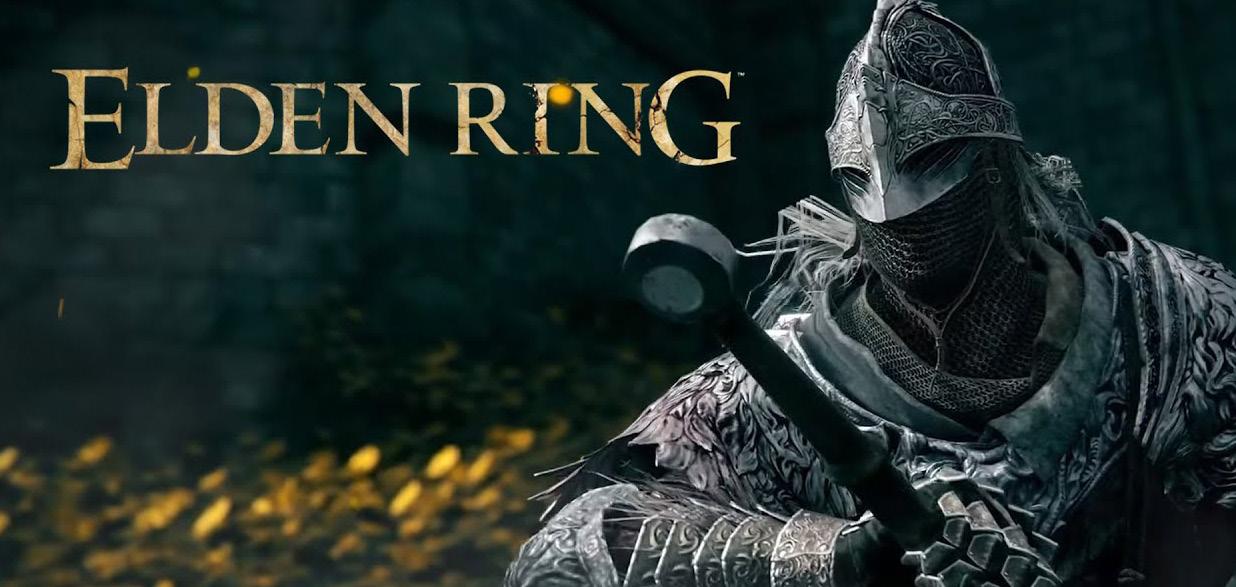
Best GAMES
IN 2022
Jake P, Year 9 writes...
In 1939, a publisher by the name Martin Goodman founded Timely Comics in New York City. That name might not ring any bells or turn any heads. Yet, over the years, Timely Comics evolution has amassed a multi-billion dollar company and it is one of Disney’s biggest and most successful acquisitions ever. Timely Comics is the early name of the comic giant: Marvel Comics.


Marvel has had an incredible history since its creation, in 1939, by publisher Martin Goodman, when he noticed the rising market of comic books. Starting with just a few staff, they created entries with characters like The Human Torch and The Angel that quickly sold over a million copies. Then new Timely Comics cartoonists, Joe Simon and Jack Kirby, created Captain America which completely took off and comic issues surrounding the character started the Marvel legacy. Kirby left Marvel (for the first time) to work for DC and Goodman promoted an assistant, working at
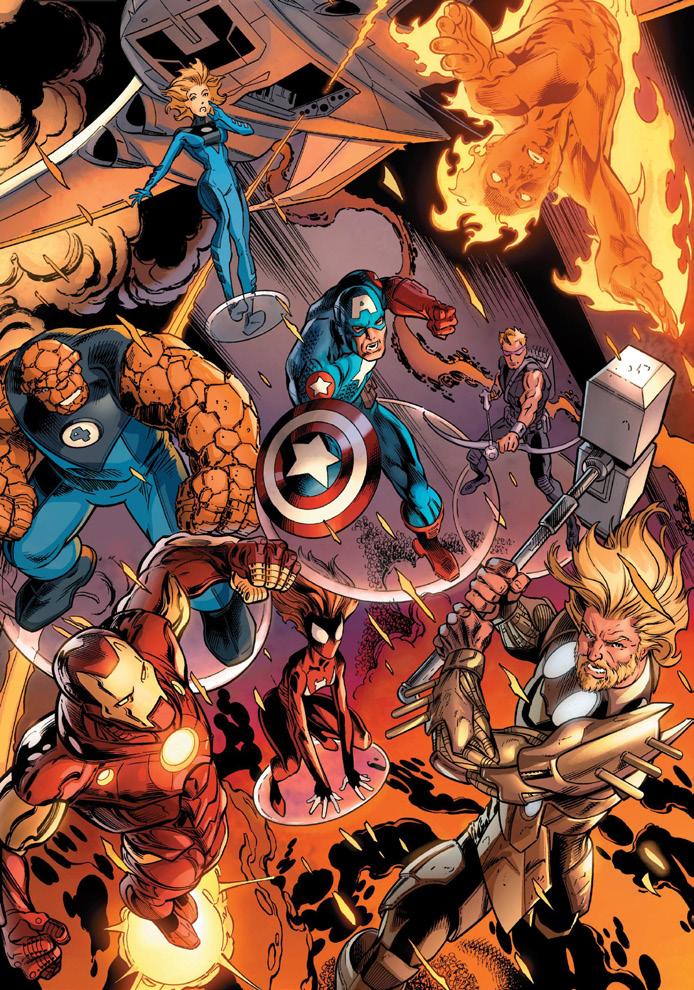
the company since its early start in 1939, to a comic editor job. Stanley Bieber was just 19 years old when he started to write and create his own characters, as an editor, at Timely Comics.
Stanley Bieber created hundreds of characters and critically-acclaimed stories under the pseudonym ‘Stan Lee’. Eventually, after huge success, he was promoted to publisher, then vice president of Marvel Comics. The company went through two name changes, from Timely to Atlas Comics, evolving into Marvel in 1961. By the 80s, Marvel was still going strong and also making their first film, Howard the Duck, in 1986. This grossed 38 million dollars worldwide. Characters such as Spiderman, the Avengers and X Men were selling millions of comics worldwide and X Men Origins: 1 is now the most successful single-issue comic ever, selling over 8.2 million copies.
Marvel’s success led to them attempt to enter the film industry again. Blade, starring Wesley Snipes as a half vampire, was released in 1998 and grossed 131
million dollars. Marvel continued with its strong line up for heroes and pursuied film up until 2008.
Then, in 2009, Disney bought Marvel and all of its subsidiaries: Marvel Entertainment (now Marvel Studios), Marvel Comics, Marvel Music, Marvel Television and Marvel Games. Disney paid 4 billion dollars for Marvel and started the MCU, now the biggest move franchise on the planet, grossing over 25 billion dollars in 14 years. The MCU has built an avid fanbase and around 54 percent of adults in the US have seen a Marvel film, which is about 160 million people. An inspiring story from rags to riches!
TIMELY COMICS
This is Horizon: Forbidden West, an action-adventure RPG released early this year. It is the highly anticipated sequel to Horizon: Zero Dawn, continuing the story a few months on from its predecessor. Inexperienced players are encouraged to buy the first game but is not necessary, as events are explained in flashbacks and the introduction/recap. The game follows the heroine, Aloy, as she discovers the forbidden west, a more savage land to the east where she is from, allowing a deeper and more difficult combat system. A welcome addition is the introduction of a custom gamemode, so you can tone down the difficulty on some aspects of the game. For example, you can make Aloy take less damage from opponents but have all other aspects on the default setting.
The intro can be boring at times, as there is no variation between enemy types and the slitherfang (a large machine resembling a cobra) and it is frustratingly difficult on
the hardest mode, as you only have 200 health on a boss fight with two stages. However, once you reach the west everything from then on is beautiful.
You are treated to a challenging fight when you first enter the west but using acid or a spikethrower will make that easier. The two cutscenes you witness, during this stage, are quite brutal and a spectacle for the eyes. Afterwards, you see a significant difference in terrain. It is mountainous biome and a stark contrast to the greenery of the East.
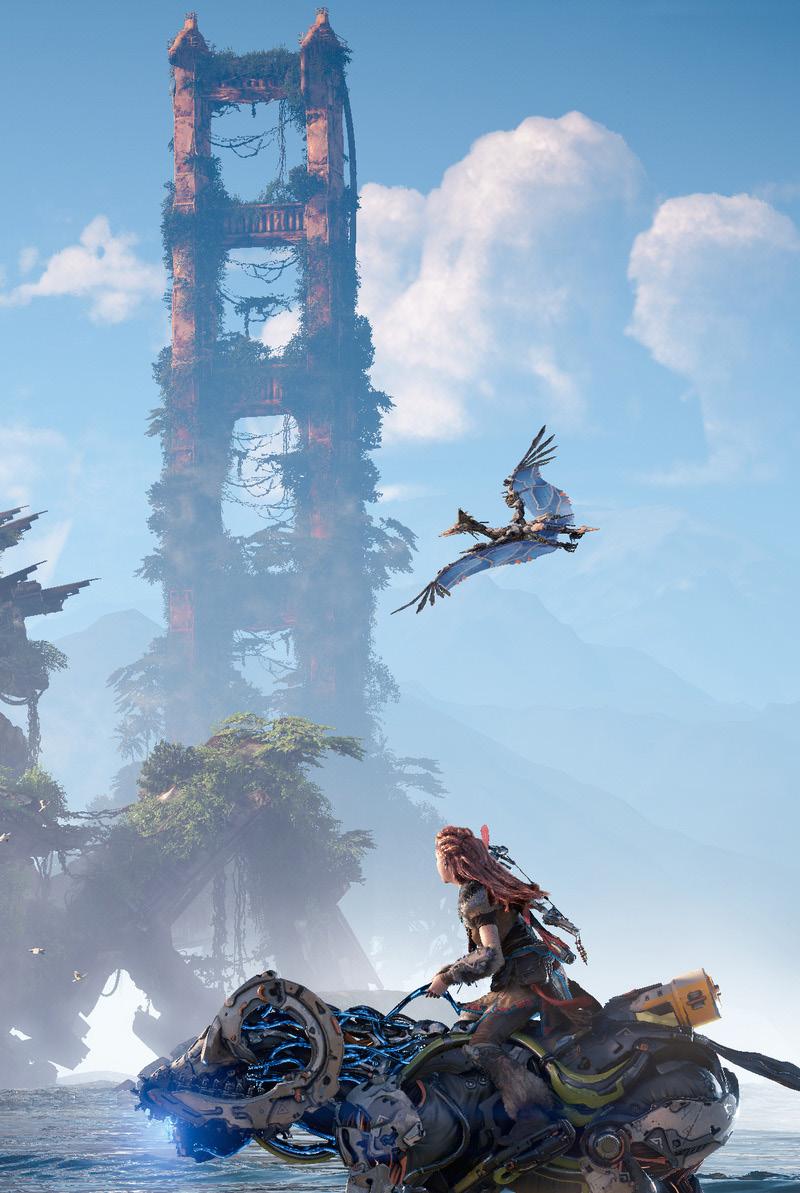
Unlike in the intro, where combat is usually to be avoided, here every fight is exhilarating. When you reach this stage, you will have probably levelled up enough to purchase skills. The skill tree has five sections: Warrior, Hunter, Survivor, Infiltrator, and Machine Master. These focus on all abilities useful to survive hostile encounters. My personal priority was Warrior, which focuses on melee combat. There is a heavy emphasis on ranged combat in the game but, for a while, the standard hunter bow is not effective for taking out large groups. There is also a core power, up on each section, that can be acquired only when all surrounding skills are earned. These include making your spear deal electric damage on the Warrior section, having a higher FOV on the Hunter section, and turning invisible on the Infiltrator section (there are more of these, but I have only listed notable ones).
As exceptional as this game was, there are a few downsides. Some are major but most are minor, so
should not discourage you (I will not mention minor problems).
1. As I have mentioned, the combat has a lot more ranged choices than melee choices, which is a shame because other Sony titles, such as God of War, have melee combat as a satisfying and efficient option, rather than a backup.
2. The Tomb of Ted Faro. This was a built-up part of the game but it felt quite underwhelming at the payoff. Firstly, the suit you receive looks terrible. It is a good armour set but it looks awful, literally a brown rag. Secondly, the player hears a monstrous roar, which is implied to be Ted Faro as a Godzilla-esque mutation, due to radioactive waste, but we never get to fight it. We never even see it and leave the tomb as it collapses.
3. Most side quests are not great. One thing GuerrillaGames have missed the mark on, with this game, is the side quests. You just don’t feel any priority to complete most of them. While Maw of the Arena is exhilarating to unlock and play through, most other things are fun but not rewarding.
SPOILERS AHEAD
The game opens with Sylens giving a monologue about the world this game takes place in, also a recap to new and returning players. We then cut to Aloy being tracked down by her good friend, Varl, and them travelling to the ruins of a temple in a jungle. On this journey, we are given opportunities to use the mechanics and combat system. When you reach the temple, we are told that Aloy has been
THIS IS HORIZON: FORBIDDEN WEST
Hassan Y-N, Year 7 writes...
travelling to find an artificial intelligence called GAIA. Aloy finds that the ruined temple has a holographic message from a man called Travis Tate, informing her that he has securely hidden the backup of GAIA somewhere else. Aloy then journeys deeper into the jungle, where she finds a destroyed Oseram campsite and we craft a Pullcaster, used to grapple onto highlighted objects or pull certain objects aside.
After travelling, we find the remains of a rocket ship and its landing platform. We jump down and fight waves of small machines. Once you pass that stage, you drop a rocket on two fighting slitherfangs. The rocket kills one and traps the other. Here you fight a slitherfang for the first time.
The slitherfang is a large machine, reminiscent of a cobra. It fires acid at you that causes damage over time. To easily kill it, you must shoot at its weakpoints which will be highlighted by pressing R3. Once you have depleted half of its health bar, it will break free of its confines and start using its entire body to move around, and use its tail to electrocute a small vicinity of the boss arena. When you finally defeat the opponent, you will finish the introduction to Horizon: Forbidden West and, in a beautiful cutscene, you travel to Meridian, where Aloy defeated the evil AI Hades in the previous game. There you retrieve a lance from the top of a spire, Aloy learns that an old friend of hers - Sylens - has stolen Hades to extract its precious knowledge. Sylens reveals that he is living in in the savage west and gives her a set of coordinates. She deserts Varl and her friends to travel to Barren Light, the border between the east and west lands.
Aloy is denied access to the gate to the gate by the commanding officer, Commander Nozar, but her friend, Erend, convinces Nozar to let Aloy through. She is met by tenakth chiefs but, before they can have a long reaction, the rebel queen, Regalla, ambushes the tribes of the tenakth and deploys bristlebacks and chargers to attack. In this fight, you are surrounded by opponents circling you and riders of machines shooting you with medium-range, fast firing warrior bows.
Once you defeat the machines, you fight the rebel champion, known as Grudda. In the ensuing battle, you gain a shieldwing allowing you to glide between vast distances. Subsequently, violent cutscenes show all the chiefs being killed by machines, General Kotallo’s arm being ripped off, and then Regalla threatens Hekarro, the ruler of the entire western lands. Aloy travels to the coordinates she extracted from the spire and finds the remains of a small camp, made by Sylens, and a console that plays a holographic message, that shows Sylens prompting HADES for answers. Sylens had contained HADES in an orb at this site and left a trail leading from there to a ruined Faro facility. The orb is there and Aloy connects her staff to the orb and extracts HADES.
A hologram appears of Sylens, in real time, informing Aloy there is a gene-locked hatch in the facility leading to a backup of GAIA. You, as the player, must beat a parkour course to reach the hatch. Once you do, you enter a room containing the backup of GAIA. However, we discover that the backup has no subordinate functions. These are: MINERVA, POSEIDON, HEPHAESTUS, HADES, DEMETER, AEHTER, APOLLO, ARTEMIS and ELEUTHIA. Aloy manages to make contact with MINERVA and finds its location. If they can claim MINERVA, they can launch GAIA’s heuristic matrix and then GAIA can help them find the rest of the functions. Suddenly, intruders open the gene-hatch, with their own clone of Elisabet Sobeck (which is what Aloy is). They retrieve the other GAIA backup, manage to find Aloy, and one of them tries to kill her while the others leave with their clone and Specters.

That is all I will reveal about the game because some major spoilers are just beyond, and I want anyone buying this, on my recommendation, to experience these for themselves.
I hope you enjoyed this article (completing the game took days) and my official rating is 9/10.
WRITE FOR US
Do you have something you’d like to write about?
Is there a passion or interest you’d like to share with others?
Is there a cause you would like to draw attention to?
Would you like to report on school events?
Are you a great photographer or artist?
Send your articles (and images to go with them) to nicola.bradley@wetherbysenior.co.uk, or ask to be added to the team on Teams where you can submit it directly.
A submission deadline will be set each half term, so get writing so your article can be included!





 Mikey W, Year 7 writes...
Mikey W, Year 7 writes...





 Daniel W, Year 9 writes...
Daniel W, Year 9 writes...




















 Sebastian H-H, Year 9 writes...
Sebastian H-H, Year 9 writes...





 Felipe E, Year 8 interviews Miss Vanags, science teacher and Year 7 form tutor...
Felipe E, Year 8 interviews Miss Vanags, science teacher and Year 7 form tutor...










